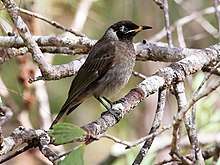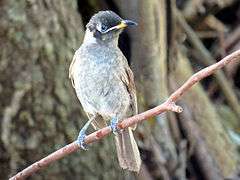Bridled honeyeater
The Bridled Honeyeater (Bolemoreus frenatus) is a species of bird in the family Meliphagidae with distinctive rein-like markings on its face that is endemic to northeastern Queensland. It is found in subtropical or tropical moist upland forests and subtropical or tropical rainforests, usually above 300 meters. In winter, it descends to lower forests including mangroves, and can sometimes be seen in more open habitats.
| Bridled honeyeater | |
|---|---|
 | |
| Scientific classification | |
| Kingdom: | Animalia |
| Phylum: | Chordata |
| Class: | Aves |
| Order: | Passeriformes |
| Family: | Meliphagidae |
| Genus: | Bolemoreus |
| Species: | B. frenatus |
| Binomial name | |
| Bolemoreus frenatus (Ramsay, 1875) | |
| Synonyms | |
|
Lichenostomus frenatus | |
Description
The Bridled Honeyeater is a medium to large dusky white-gaped honeyeater with a bicoloured bill. It has a blue eye with a yellow line below and white line behind, a yellow tuft on ear and a large, white-grey patch on the side of the neck.[2][3]
Taxonomy and systematics
The scientific name for the Bridled Honeyeater is Bolemoreus frenatus (Ramsay, 1874).[4] Initially designated Ptilotis frenata Ramsay, E.P. 1874, then Lichenostomus frenatus and lastly Bolemoreus frenatus.[5]
Both the Bridled Honeyeater and Eungella Honeyeater were previously placed in the genus Lichenostomus, but were moved to Bolemoreus after a molecular phylogenetic analysis, published in 2011, showed that the original genus was not a natural unit.[6][7] [8] The bird belongs to the family Meliphagidae.[5]
The Australian Museum holds syntypes for this species numbered AM O.18560 an adult female, AM O.18561 adult male and AM O.18562 adult female all found in the Cardwell area of Queensland.[5]
The genus name, Bolemoreus, was created in 2011 and derives from "Boles and Longmore's bird" which honours Walter Boles and N. Wayne Longmore two Australian ornithologists.[9] The species name, frenatus, was proposed by Ramsay[4] from the Latin for bridle or reins referring to the markings on the face and base of bill.[9]
Behaviour and ecology
The Bridled Honeyeater is found in upland rainforest and wet eucalypt forest above an altitude of 300 metres in the Atherton region, north-east Queensland, Australia.[10] The range extends from the Bloomfield-Mt Amos area south to Mt Spec. Some birds move to lower altitude in Winter.[3] The population is considered to be stable with no identified threats or declines.[10] Population isn't quantified although it is considered common in some parts of its range.[1]
When trees are fruiting or flowering the honeyeater may gather in large, quarrelsome flocks but they are otherwise solitary and elusive.[3]
Gallery

 Julatten, north Queensland, Australia.
Julatten, north Queensland, Australia.
References
- BirdLife International (2012). "Lichenostomus frenatus". IUCN Red List of Threatened Species. 2012. Retrieved 26 November 2013.CS1 maint: ref=harv (link)
- Slater, Peter; Slater, Pat; Slater, Raoul (2009). The Slater Field Guide to Australian Birds (2nd ed.). London, Sydney, Auckland: Reed New Holland. pp. 298–299. ISBN 9781877069635.
- Menkhorst, Peter; Rogers, Danny; Clarke, Rohan; Davies, Jeff; Marsack, Peter; Franklin, Kim (2017). The Australian Bird Guide. Clayton, Vic: CSIRO Publishing. pp. 388–389. ISBN 0643097546.
- Ramsay, E.P. (15 Aug 1874). "Natural history. Australian Zoology. The following descriptions of three species of birds new to science". Sydney Mail. p. 201.
- "Species Bolemoreus frenatus (Ramsay, 1874), Bridled Honeyeater: Australian Faunal Directory". biodiversity.org.au. Retrieved 2020-05-12.
- Nyári, Á.S.; Joseph, L. (2011). "Systematic dismantlement of Lichenostomus improves the basis for understanding relationships within the honeyeaters (Meliphagidae) and historical development of Australo–Papuan bird communities". Emu. 111: 202–211. doi:10.1071/mu10047.
- Gill, Frank; Donsker, David (eds.). "Honeyeaters". World Bird List Version 6.1. International Ornithologists' Union. Retrieved 28 January 2016.
- Boles, Walter. "Eungella Honeyeater". The Australian Museum. Retrieved 2020-05-15.
- Fraser, Ian; Gray, Jeannie (2019). Australian Bird Names: Origins and Meanings. Clayton South, Vic: CSIRO Publishing. pp. 184, 198–199. ISBN 9781486311637.
- Ekstrom, J; Butchart, S; M, Harding; Fisher, S (2020). "BirdLife International (2020) Species factsheet: Bolemoreus frenatus". Birdlife International. Retrieved 15 May 2020.
